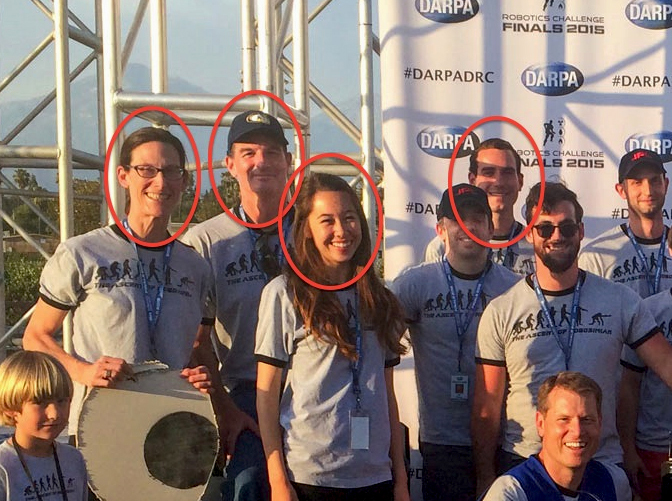Future Simian

Drive up, get out of the car, make your way to the front door, open said door, step inside. We humans have performed this sequence of maneuvers countless times: going to work in the morning, coming home after a night of partying, in various kinds of weather and locations and at different hours of the day. For the most part, it’s effortless and unconscious.
But, that same set of movements is a huge challenge for robots, as UC Santa Barbara professor Katie Byl and her robotics team can attest. RoboSimian, a collaboration between Byl’s team and researchers from the California Institute of Technology and NASA’s Jet Propulsion Laboratory at Caltech, completed the Defense Advanced Research Projects Agency’s (DARPA) Robotics Challenge Finals in early June and came in fifth out of about two dozen teams from across the country and around the globe.
“I’m really happy with how we did,” said Byl, professor of electrical and computer engineering and of mechanical engineering at UCSB. “JPL designed and built RoboSimian, and my students — Brian Satzinger and Chelsea Lau — and I at UCSB have been helping JPL to write the software to control how the robot moves for the DARPA Robotics Challenge.” The DARPA contest’s overarching theme was to have competitors produce a robot that could eventually handle unpredictable terrain and manipulate tools for use in conditions inhospitable to humans. Think Fukushima nuclear plant meltdown or other disaster-response situations.
But first, the competitors had to figure out how to get their robots — many of them upright and bipedal — to drive the car proficiently, get out of the vehicle without losing balance and travel to the door and open it without keeling over. Proprioception, the ability of humans and animals to sense their positions relative to the environment and adjust their bodies’ reactions and movements to maintain balance under varying conditions, still has some way to go before it can be replicated in machines.
However, RoboSimian is ahead of the curve. It was one of only two robots (the other one is called CHIMP) that didn’t require human intervention to reset during either day of competition. The most common failure mode for other robots was falling down.
“RoboSimian has a phenomenal track record,” said Byl, whose research focuses on robot agility, reliability and response in variable conditions. “It’s fallen down maybe once in the past year of testing.” Even the creators of the winning robot, a humanoid designed by the Korea Advanced Institute of Science and Technology, had to take advantage of the grace period built into the competition that allows the robots’ handlers to reset their machines on the first day of testing, said Byl.
At about 275 pounds and built with a low center of mass for stability, RoboSimian looks more like an ape or a four-footed spider. Unlike the more humanoid robots, RoboSimian has limbs that are designed with equal strengths and articulations to make the robot versatile in different situations, such as navigating uneven terrain, or grasping onto things to hoist itself up and climb over objects, or holding and operating simple human tools.
Named King Louie, the RoboSimian that participated in this DARPA challenge is the second-generation robot of its kind and represents roughly two years of research, design, build and testing for its creators. Their fifth-place finish — one spot ahead of MIT — is proof of the promising technology developed by the team.
“We’re really excited about the idea of continuing to work with RoboSimian,” said Byl. “It’s really interesting to think about the idea of having a robot where the same limbs can be used as arms or legs.” Future efforts may concentrate on refining the robot’s sense of balance, enabling more autonomous mobility in complex environments, and reducing time delays during teleoperation.



